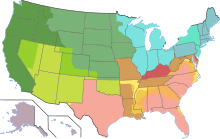
From the late 18th to the mid-19th century, various states of the United States allowed the enslavement of human beings, most of whom had been transported from Africa during the Atlantic slave trade or were their descendants. The institution of chattel slavery was established in North America in the 16th century under Spanish colonization, British colonization, French colonization, and Dutch colonization.
After the United States was founded in 1776, the country split into slave states (states permitting slavery) and free states (states prohibiting slavery). Slavery became concentrated in the Southern United States. The Act Prohibiting Importation of Slaves in 1807 banned the Atlantic slave trade, but not the domestic slave trade or slavery itself. Slavery was finally ended throughout the entire country after the American Civil War (1861–1865), in which the U.S. government defeated a confederation of rebelling slave states that attempted to secede from the U.S. in order to preserve the institution of slavery. During the war, U.S. President Abraham Lincoln issued the Emancipation Proclamation, which ordered the liberation of all slaves in rebelling states. In December 1865, the Thirteenth Amendment to the U.S. Constitution was ratified, abolishing chattel slavery nationwide. Native American slave ownership also persisted until 1866, when the federal government negotiated new treaties with the "Five Civilized Tribes" in which they agreed to end slavery.[1] In June 2021, Juneteenth, a day that commemorates the end of slavery in the U.S., became a federal holiday.
- ^ Neil P. Chatelain (July 10, 2018). "Beyond the 13th Amendment: Ending Slavery in the Indian Territory". Archived from the original on April 7, 2023. Retrieved June 24, 2023.